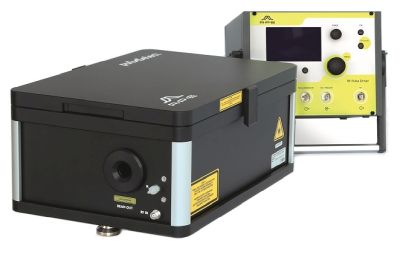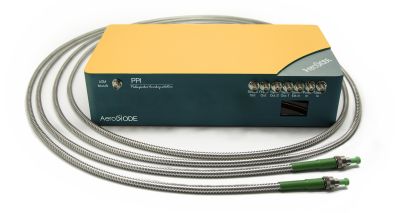pulse repetition rate (original) (raw)
Author: the photonics expert (RP)
Acronym: PRF
Definition: the number of pulses emitted per second e.g. by a mode-locked or Q-switched laser
Alternative term: pulse repetition frequency
Categories:  optical metrology,
optical metrology,  light pulses
light pulses
Units: Hz
Formula symbol: <$f_\textrm{rep}$>
DOI: 10.61835/aep [Cite the article](encyclopedia%5Fcite.html?article=pulse repetition rate&doi=10.61835/aep): BibTex plain textHTML Link to this page LinkedIn
The pulse repetition rate (or pulse repetition frequency) <$f_\rm{rep}$> of a regular train of pulses is defined as the number of emitted pulses per second, or more precisely the inverse temporal pulse spacing.
Depending on the technique of pulse generation (concerning light pulses), typical pulse repetition rates can be in different parameter regions:
- Typical mode-locked solid-state lasers emit with pulse repetition rates between 50 MHz and a few gigahertz, but in extreme cases < 10 MHz or > 100 GHz are possible. In most cases, there is a single pulse circulating in such a laser, so that the pulse repetition rate is the inverse round-trip time in the laser resonator.
- Q switching of solid-state lasers typically allows repetition rates from below 1 Hz to the order of 100 kHz. For active Q switching, the pulse repetition rate is determined by an external drive signal, while for passive Q switching its depends on the magnitude of loss modulation, the pump power and various other parameters.
- Gain switching of semiconductor lasers can provide repetition rates from below 1 Hz to many megahertz.
- Attosecond pulse trains of finite length can be generated via high harmonic generation with repetition rates of hundreds of terahertz. Here, the pulse repetition rate is twice the optical frequency of the pump light.
The article on pulse trains for methods of multiplying or dividing the pulse repetition rate.
For burst mode lasers, there are two different repetition rates: the pulse repetition rate within each burst and the much lower repetition rate of the bursts.
If a pulse train is regular and the pulses are mutually coherent, the optical spectrum of the pulse train is a frequency comb, where the spacing of the lines is determined by the pulse repetition rate.
The deviation from perfect periodicity of the optical power is called timing jitter.
More to Learn
Encyclopedia articles:
Suppliers
The RP Photonics Buyer's Guide contains 20 suppliers for pulse pickers. Among them:
APE
pulseSelect is an acousto-optic pulse picker, developed for the special demands of femtosecond laser technology. Pulse distortion is minimized by a low dispersive design and the use of reflective optics. High repetition rates and high contrast rates are achieved by using acousto-optical elements. The pulse repetition rate can be reduced by an adjustable internal frequency divider or by external triggering.
APE offers pulse pickers for either a wavelength range from 500 nm to 1600 nm or dual wavelength bands from 340 nm to 540 nm and from 680 nm to 1080 nm.
ALPHALAS
Based on proprietary technology, ALPHALAS offers most advanced pulse pickers for selecting single pulses from a train of picosecond or femtosecond optical trains. Large amplitudes of > 10 kV, pulse widths FWHM of 7 … 10 ns and repetition rates up to 10 kHz in combination with a specially designed short-crystal Pockels cell are best suited for selecting individual pulses from various mode-locked lasers. Low jitter of < 40 ps and short delay of typically 30 ns guarantee a precise synchronization for perfect pulse selection.
Exail
The ModBox-OPP optical pulse picker allows to pick and optionally shape any sub-nanosecond pulse pattern or pulse sequence in an incoming pulse train. It acts as a fast gate with low insertion loss and high extinction from 30 dB to above 55 dB with high stability over time, and with user-adjustable optical pulse duration and optical pulse train repetition rate (when pre-scaler option is embedded).
GWU-Lasertechnik
GWU’s UHG-PSK Series has been designed for ultrafast laser oscillators. It offers pulse picking with highest output powers and optimum contrast ratio. The system is suitable for femtosecond and picosecond pulses with high input powers, without requiring any attenuation. Integral pulse selecting from single shot to 40 MHz with adjustable contrast ratio is possible by a convenient software control. The UHG Pulse Selector is either available as standalone version or it can be integrated in our Harmonic Generator, where it is positioned before all harmonic stages to offer all features in a single compact housing.
UHG Pulse Selector features and benefits:
- modular design: standalone version or integrated in our Harmonic Generator
- high pulse picking efficiency
- adjustable contrast ratio
- suitable for high fs/ps power without any attenuation
- convenient and user-friendly software control
AeroDIODE
SHIPS TODAY: Pulse Picker is a synchronization tool for driving external modulation devices such as EOMs, AOMs or SOAs in a pulse-picking mode of operation. It has been designed to work with low level electrical or optical input pulse power like typically the signal coming from a photodiode. It includes 3 pulse picking modes (frequency divider, external triggering & high frequency clock, burst shaping). The Pulse Picker board includes a software-adjustable input voltage level threshold and an (optional) photodiode. This board also includes a special AWG function synchronized with the input signal to perform burst shaping of mode-locked lasers.
NEW: A turn-key pulse-picker solution is now offered covering the full wavelength range between 700 and 1750 nm. It includes the synchronization board described above with our high performances AOMs and drivers.
See our detailed application note for Pulse Picker.
EKSMA OPTICS
With the EKSMA Optics opto-electronic laser pulse picking system, femtosecond pulses can be picked from a pulse train at up to 2 MHz rate. The pulse picker UP2 and digital synchronization and delay pulse generator pMaster 4.2 can be synchronized with lasers operating at up to 100 MHz rate. The pulse picker MP1 can select pulses at up to 600 kHz repetition rate and be synchronized with lasers generating pulse trains with up to 60 MHz repetition rate.
Questions and Comments from Users
Here you can submit questions and comments. As far as they get accepted by the author, they will appear above this paragraph together with the author’s answer. The author will decide on acceptance based on certain criteria. Essentially, the issue must be of sufficiently broad interest.
Please do not enter personal data here. (See also our privacy declaration.) If you wish to receive personal feedback or consultancy from the author, please contact him, e.g. via e-mail.
By submitting the information, you give your consent to the potential publication of your inputs on our website according to our rules. (If you later retract your consent, we will delete those inputs.) As your inputs are first reviewed by the author, they may be published with some delay.











